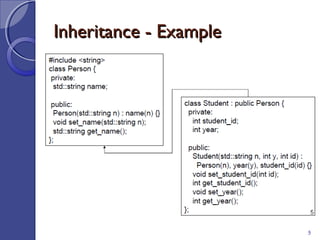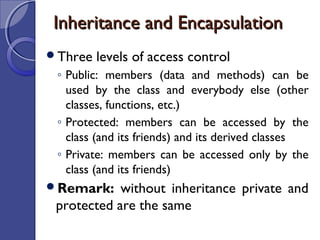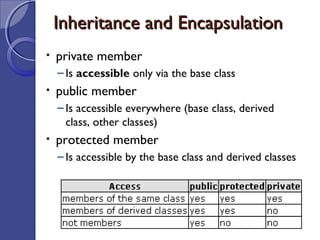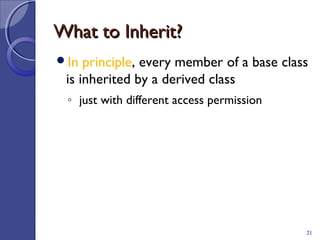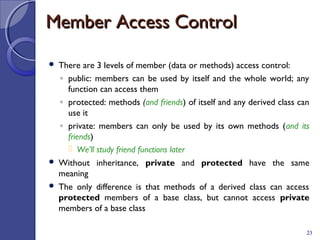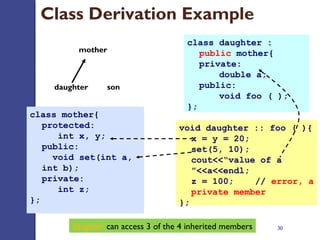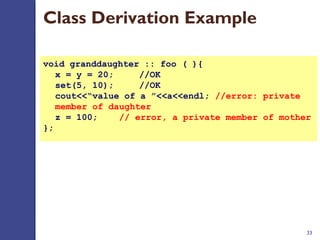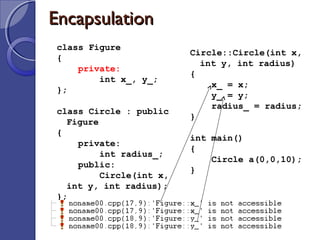Inheritance, Object Oriented Programming
- 1. Course:Course: Object Oriented ProgrammingObject Oriented Programming 4.00 Credit Hours, Spring 2014,4.00 Credit Hours, Spring 2014, Undergraduate ProgramUndergraduate Program Instructor: Sabeen JavaidInstructor: Sabeen Javaid SESSION 1, 2SESSION 1, 2 InheritanceInheritance
- 2. InheritanceInheritance Inheritance is a relationship between two or more classes where derived class inherits behaviour and attributes of pre- existing (base) classes Intended to help reuse of existing code with little or no modification 2
- 3. InheritanceInheritance The existing class is called the base class, and the new class is called the derived class. Other programming languages, such as Java and C#, refer to the base class as the superclass and the derived class as the subclass. A derived class represents a more specialized group of objects. 3
- 4. InheritanceInheritance It is expressed in C++ by the “ : public “ syntax: ◦ class Car : public Vehicle {}; Car “is a” / “is derived from” / “is a specialized” / “is a subclass of” / “is a derived class of” Vehicle Vehicle “is a base class of” / “is a super class of” Car 4
- 5. Inheritance - ExampleInheritance - Example 5
- 6. Inheritance - ExampleInheritance - Example 6
- 7. Inheritance: is-A RelationshipInheritance: is-A Relationship Derived class objects can always be treated like a base class objects Example: an object of type Student can always be used like an object of type Person ◦ Especially, we can call all methods of Person on an object of type Student 7
- 8. InheritanceInheritance • Inheritance can be continuous –Derived class can inherit from a base class –The derived class can act as a base class and another class can inherit from it –If you change the base class, all derived classes also change –Any changes in the derived class do not change the base class –All features of the base class are available in the derived class • However, the additional features in the derived class are not available in the base class 8
- 9. 9 Base Classes and Derived Classes
- 12. 12 Inheritance a b Class A Features: a,b c Class B Features: a,b,c d e Class C Features: a,b,d,e f Class D Features: a,b,d,e,f
- 13. Inheritance and EncapsulationInheritance and Encapsulation Three levels of access control ◦ Public: members (data and methods) can be used by the class and everybody else (other classes, functions, etc.) ◦ Protected: members can be accessed by the class (and its friends) and its derived classes ◦ Private: members can be accessed only by the class (and its friends) Remark: without inheritance private and protected are the same
- 14. Inheritance and EncapsulationInheritance and Encapsulation • private member – Is accessible only via the base class • public member – Is accessible everywhere (base class, derived class, other classes) • protected member – Is accessible by the base class and derived classes
- 15. 15 Inheritance Concept Rectangle Triangle Polygon class Polygon { private: int width, length; public: void set(int w, int l); }; class Rectangle{ private: int width, length; public: void set(int w, int l); int area(); }; class Triangle{ private: int width, length; public: void set(int w, int l); int area(); };
- 16. 16 Rectangle Triangle Polygon class Polygon { protected: int width, length; public: void set(int w, int l); }; class Rectangle: public Polygon { public: int area(); }; class Rectangle{ protected: int width, length; public: void set(int w, int l); int area(); Inheritance Concept
- 17. 17 Rectangle Triangle Polygon class Polygon { protected: int width, length; public: void set(int w, int l); }; class Triangle : public Polygon { public: int area(); }; class Triangle{ protected: int width, length; public: void set(int w, int l); int area(); Inheritance Concept
- 18. 18 Inheritance Concept Point Circle 3D-Point class Point { protected: int x, y; public: void set(int a, int b); }; class Circle : public Point { private: double r; }; class 3D-Point: public Point { private: int z; }; x y x y r x y z
- 19. class DerivedClassName : access-level BaseClassName Declaring InheritanceDeclaring Inheritance • Syntax: where –access-level specifies the type of derivation • private by default, or • public or • protected (used very rarely) • Any class can serve as a base class –Thus a derived class can also be a base class 19
- 20. 20 Class Derivation Point 3D-Point class Point{ protected: int x, y; public: void set(int a, int b); }; class 3D-Point : public Point{ private: double z; … … }; class Sphere : public 3D-Point{ private: double r; … … }; Sphere Point is the base class of 3D-Point, while 3D-Point is the base class of Sphere
- 21. What to Inherit?What to Inherit? In principle, every member of a base class is inherited by a derived class ◦ just with different access permission 21
- 22. 22 Access Control Over the Members • Two levels of access control over class members – class definition – inheritance type class Point{ protected: int x, y; public: void set(int a, int b); }; class Circle : public Point{ … … };
- 23. Member Access ControlMember Access Control There are 3 levels of member (data or methods) access control: ◦ public: members can be used by itself and the whole world; any function can access them ◦ protected: methods (and friends) of itself and any derived class can use it ◦ private: members can only be used by its own methods (and its friends) We’ll study friend functions later Without inheritance, private and protected have the same meaning The only difference is that methods of a derived class can access protected members of a base class, but cannot access private members of a base class 23
- 24. 24 Access Rights of Derived ClassesAccess Rights of Derived Classes • Public inheritance preserves the original accessibility of the base class public and protected members in the derived class – (base) public -> (derived) public – (base) protected -> (derived) protected – (base) private -> no access • Protected inheritance causes public members to become protected (protected members are preserved) in the derived class – (base) public -> (derived) protected – (base) protected -> (derived) protected – (base) private -> no access
- 25. 25 Access Rights of Derived ClassesAccess Rights of Derived Classes • Private inheritance causes all members to become private in the derived class – (base) public -> (derived) private – (base) protected -> (derived) private – (base) private -> no access
- 26. Access Rights of Derived Classes -Access Rights of Derived Classes - SummarySummary The type of inheritance defines the minimum access level for the members of derived class that are inherited from the base class With public inheritance, the derived class follows the same access permission as in the base class With protected inheritance, only the public members inherited from the base class can be accessed in the derived class as protected members With private inheritance, all members from the base class are inherited as private. This means private members stay private, and protected and public members become private. private protected public private private private private protected private protected protected public private protected public Type of Inheritance AccessControl forMembers
- 27. Access Rights of Derived ClassesAccess Rights of Derived Classes Take these classes as examples: class B { /*...*/ }; class D_priv : private B { /*...*/ }; class D_prot : protected B { /*...*/ }; class D_publ : public B { /*...*/ }; class UserClass { B b; /*...*/ }; None of the derived classes can access anything that is private in B In D_priv, the public and protected parts of B are private In D_prot, the public and protected parts of B are protected In D_publ, the public parts of B are public and the protected parts of B are protected (D_publ is-a-kind-of-a B) class UserClass can access only the public parts of B, which "seals off" UserClass from B 27
- 28. 28 protected vs. private So why not always use protected instead of private? – Because protected means that we have less encapsulation – All derived classes can access protected data members of the base class – Assume that later you decided to change the implementation of the base class having the protected data members – For example, we might want to represent address by a new class called Address instead of string – If the address data member is private, we can easily make this change – The class documentation does not need to be changed. – If it is protected, we have to go through all derived classes and change them – We also need to update the class documentation.
- 29. 29 When to use Private InheritanceWhen to use Private Inheritance • Overall private and protected inheritance are used very rarely • Private and protected inheritance are used to represent implementation details • Protected bases are useful in class hierarchies in which further derivation is needed • Private bases are useful when defining a class by restricting the interface to a base so that stronger guarantees can be provided
- 30. 30 Class Derivation Example mother daughter son class mother{ protected: int x, y; public: void set(int a, int b); private: int z; }; class daughter : public mother{ private: double a; public: void foo ( ); }; void daughter :: foo ( ){ x = y = 20; set(5, 10); cout<<“value of a ”<<a<<endl; z = 100; // error, a private member }; daughter can access 3 of the 4 inherited members
- 31. Class DerivationClass Derivation mother daughter son class mother{ protected: int x, y; public: void set(int a, int b); private: int z; } class son : protected mother{ private: double b; public: void foo ( ); } void son :: foo ( ){ x = y = 20; set(5, 10); cout<<“value of b ”<<b<<endl; z = 100; // error, not a public member } son can access only 3 of the 4 inherited member
- 32. 32 mother daughter son granddaughter grandson Class Derivation Example class mother{ protected: int x, y; public: void set(int a, int b); private: int z; }; class daughter : public mother { private: double a; public: void foo ( ); }; class granddaughter : public daughter { public: void foo ( ); };
- 33. 33 void granddaughter :: foo ( ){ x = y = 20; //OK set(5, 10); //OK cout<<“value of a ”<<a<<endl; //error: private member of daughter z = 100; // error, a private member of mother }; Class Derivation Example
- 34. 34 mother daughter son granddaughter grandson class mother{ protected: int x, y; public: void set(int a, int b); private: int z; }; class son : protected mother { private: double b; public: void foo ( ); }; class grandson : public son { public: void foo ( ); }; Class Derivation Example
- 35. 35 void grandson:: foo ( ){ x = y = 20; set(5, 10); z = 100; // error, a private member of mother }; Class Derivation Example
- 36. EncapsulationEncapsulation class Figure { protected: int x, y; }; class Circle : public Figure { public: int radius; }; int main() { Circle a; a.x = 0; a.y = 0; a.radius = 10; }
- 37. EncapsulationEncapsulation class Figure { protected: int x_, y_; }; class Circle : public Figure { private: int radius_; public: Circle(int x, int y, int radius); }; Circle::Circle(int x, int y, int radius) { x_ = x; y_ = y; radius_ = radius; } int main() { Circle a(0,0,10); }
- 38. EncapsulationEncapsulation class Figure { private: int x_, y_; }; class Circle : public Figure { private: int radius_; public: Circle(int x, int y, int radius); }; Circle::Circle(int x, int y, int radius) { x_ = x; y_ = y; radius_ = radius; } int main() { Circle a(0,0,10); }
- 39. EncapsulationEncapsulation class Figure { private: int x_, y_; public: void SetX(int x); void SetY(int y); }; void Figure::SetX(int x) { x_ = x; } void Figure::SetY(int y) { y_ = y; class Circle : public Figure { private: int radius_; public: Circle(int x, int y, int radius); }; Circle::Circle(int x, int y, int radius) { SetX(x); SetY(y); radius_ = radius; } int main() { Circle a(0,0,10); }
- 40. What to Inherit?What to Inherit? In principle, every member of a base class is inherited by a derived class ◦ just with different access permission However, there are exceptions for ◦ Constructor and destructor ◦ Overloaded Assignment operator ◦ Friends Since all these functions are class-specific! 40
- 41. References/ Compulsory ReadingReferences/ Compulsory Reading C++, How to Program Deitel & Deitel ◦ Chapter 12: OOP : Inheritance Robert Lafore ◦ Chapter 9: Inheritance ◦ http://www.learncpp.com/cpp-tutorial/115-inheri 41





